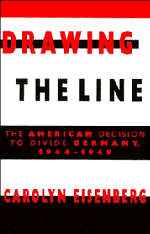Book contents
- Frontmatter
- Contents
- Preface and Acknowledgments
- Germany – Occupation Zones, 1945
- Introduction: Private Polowsky's Oath
- 1 Plans
- 2 Making Peace
- 3 The Limits of Reform: The U.S. Zone
- 4 A Fragile Friendship
- 5 The Russian Challenge
- 6 Bizonal Beginnings
- 7 The Doctors Deliberate
- 8 Marshall's Medicine
- 9 A Separate State
- 10 Cold War Germany
- 11 Winning
- Conclusion: The American Decision to Divide Germany
- Bibliography
- Index
2 - Making Peace
Published online by Cambridge University Press: 07 October 2009
- Frontmatter
- Contents
- Preface and Acknowledgments
- Germany – Occupation Zones, 1945
- Introduction: Private Polowsky's Oath
- 1 Plans
- 2 Making Peace
- 3 The Limits of Reform: The U.S. Zone
- 4 A Fragile Friendship
- 5 The Russian Challenge
- 6 Bizonal Beginnings
- 7 The Doctors Deliberate
- 8 Marshall's Medicine
- 9 A Separate State
- 10 Cold War Germany
- 11 Winning
- Conclusion: The American Decision to Divide Germany
- Bibliography
- Index
Summary
If the four of us cannot get together now in running Germany, how are we going to get together in an international organization to secure the peace of the world? We are going to have to give and take and to do a lot of things which the American public will not believe in, but we can't go there with four nations without being prepared to give and take.
(Lucius D. Clay, May 16, 1945)After long discussions and a consideration of the consequences, we came to the conclusion that this meant we had to let the Russians look to their zone for reparations and we look to ours for reparations for other countries – it also means the establishment of some form of three-party economic rule in Germany.
(John J. McCloy, July 23, 1945)The convergence of the Allied armies across the wreckage of the Third Reich was accompanied by a surge of governmental idealism. In Washington, officials went about their daily business but the perception of grand events – of immense evil vanquished, of extraordinary opportunities being born – infected even the most prosaic. At this emotional juncture, much of the hopefulness and yearning for world peace was focused on the U.S.-Soviet relationship. Despite new tensions over Poland, the aspiration for friendship was overriding. Russian assistance was still needed to finish the war in the Pacific, but the more profound concern was to prevent future great power rivalry. Twice in the twentieth century, this had led to calamitous conflagrations. Whatever the shortcomings of the Soviet regime – its totalitarian polity, its collectivist economy – it was emerging as the second strongest nation in the world, creating an imperative for accord.
- Type
- Chapter
- Information
- Drawing the LineThe American Decision to Divide Germany, 1944–1949, pp. 71 - 120Publisher: Cambridge University PressPrint publication year: 1996



